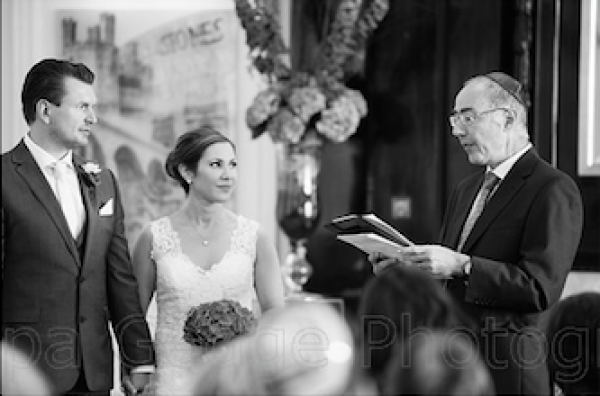
by Michael | May 6, 2024 | Blog
Of course a mixed-faith ceremony frequently is beautiful, inspiring and enjoyable.
However, such a result doesn’t just happen; it has to be worked at.
That means, not only seeking harmony among your family but also putting together the right service.
Finding a happy medium can certainly be challenging, but doesn’t need to be so.
A lot of common sense and willingness to compromise can go a long way.
If only one partner is religious, then it should be reasonable to look for a ceremony that contains the most important religious sections, but which is not too heavy.
If both partners want their own religion included, again it should be possible to come to an amicable agreement how much of each religion would be desirable.
I have conducted numerous ceremonies where the amount and subject-matter of the religious elements has been tailor-made for the couple (and/or their families). It can be done.
Incidentally, it seems to be the case that the side wanting religion (as opposed to the atheist) is more vociferous. Make of that what you will!
Most of my mixed-faith ceremonies have been for Christian and Jew. We have used certain elements of each religion, with explanations where necessary. So particular prayers or rituals have featured.
In most cases, the service has been mostly spiritual, with just a small part religious. Sometimes we use the Loving Cup ceremony and/or we might have the groom treading a glass underfoot. Other rituals are available. There can be pagan elements too, of course.
To help sort out all these choices, be prepared to co-operate with all concerned. Be reasonable and listen to their viewpoint, but remember it is YOUR ceremony.
And, most importantly, have a chat with your civil celebrant. They can help with ideas and guidance.
It doesn’t have to be a minefield.
I am waiting for your call!
photo: Phillipa Gedge
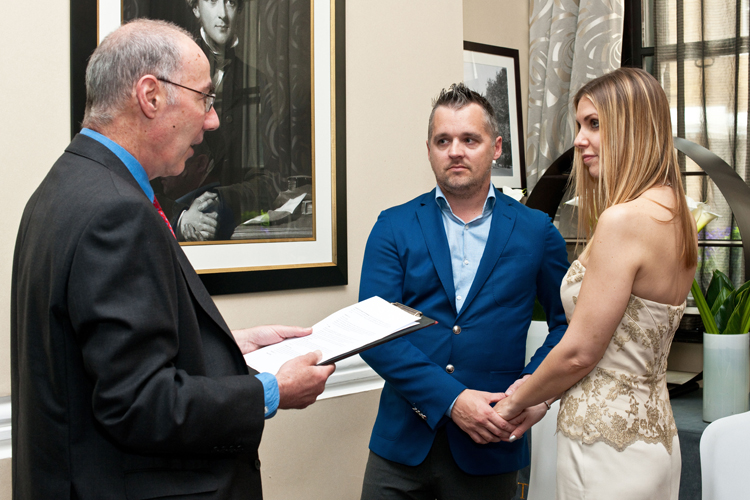
by Michael | Apr 30, 2024 | Blog
I’ve been a Civil Celebrant for some 11 years now.
Up until about 2009 I don’t think I had even heard of the profession, far less knew what a civil celebrant actually did.
So it doesn’t surprise me that there are a lot of people out there for whom the job of civil celebrant is a mystery.
Perhaps I may clarify a few things?
What I am Not
One area of confusion is that there are various types of celebrant out there.
Some offer a totally religious take; others, like the Humanists, do not. A Humanist is supposed to conduct a completely secular service, without even a mention of God.
An independent civil celebrant like myself can lead a fully secular service too, but is also able to offer a part-religious or mixed-faith service (or even a full religious one).
Your Venue and the Timing
Although the law was supposed to have changed by last July, it still stands that a legal ceremony must take place at a Register Office or at a place licensed for weddings.
In both instances, you cannot necessarily marry any day or time you choose.
The advantage of a civil celebrant ceremony is that there are no restrictions to constrain your choices. Indoors, outdoors, in a hotel, on the beach, weekday evenings, Sundays – you name it, the celebrant can accommodate you.
What’s in the Ceremony?
The celebrant-led ceremony may be a great many things.
It can be religious and quite conventional. It may be quite woo-woo, with pagan rituals, for example. It can be a combination. To decide on the sort of ceremony – and its tone and content – have a chat with your celebrant and get a few ideas (or explain your own).
This preliminary chat is invaluable as you can discuss the elements to include and also who (if anyone) is going to participate and how. You also get to know the celebrant a bit. That way, you can ask questions and check that you will be happy working with them.
So now a little of the mystery has been unveiled, I trust! You can see how the celebrant-led ceremony will ensure that you have the unique, personalised ceremony of your dreams.
If you want to discuss this further, please get in contact with me.
Photo: Victor Shack
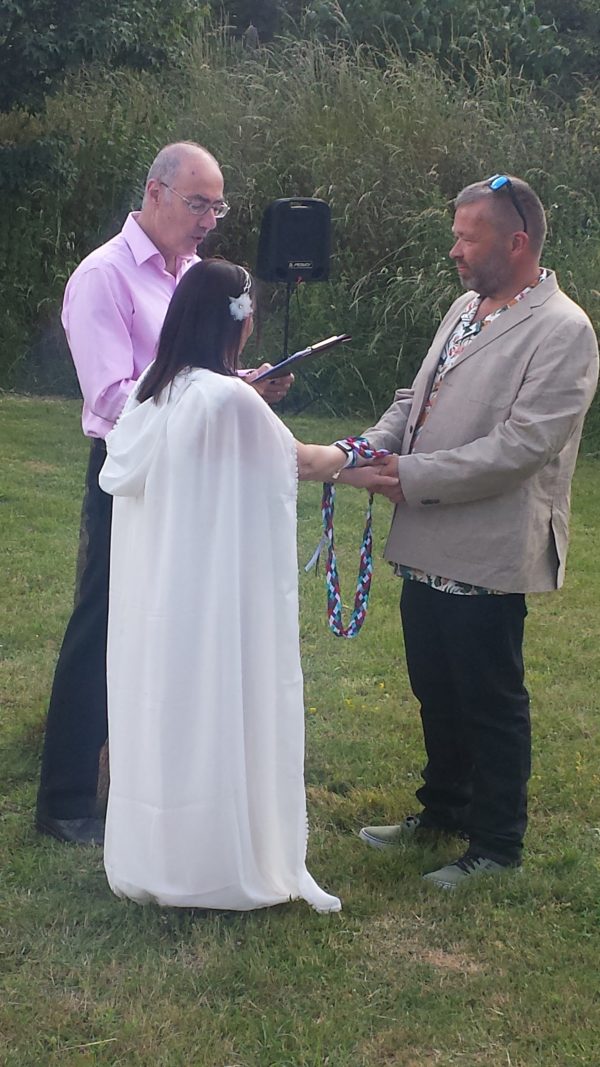
by Michael | Apr 23, 2024 | Blog
Quite a lot of people seem to have heard of the term “handfasting”, but considerably fewer know what it is.
Enlightenment is on its way!
History
Handfasting originated in pagan times, and it gained force in medieval days.
It was a way for peasants – mostly – to afford a wedding. Clergymen would usually prove too costly to hire, so an alternative was offered.
A cord could be wrapped round the couple’s wrists until their union was consummated.
They would keep the cord afterwards as a token of their love and commitment.
Up-to-date versions
In modern times, the symbolism has remained, although there are essentially two kinds of handfasting nowadays.
One kind is where the handfasting is a small (but significant) part of a larger ceremony. The other makes it one of the most important elements of the entire service.
There is a whole variety of options how you can be bound together, Cord or ribbon, usually at least 1 metre long, is commonly used. It may have several “heads” and colours. Personal preference is fine, but there are also certain colours considered more auspicious that others. You can also have the choice how the cord/ribbon is tied.
Personally, I prefer the (eternity) figure of eight.
A Full Service
Again, there is fluidity and choice as to how to put together a full service, have a chat with your celebrant beforehand. However, the following components are usual:
Sanctifying the Circle
The circle symbolises the womb of Mother Earth and the idea is to make the ceremony site a holy place. The celebrant will make a circuit, offering prayers.
Elemental Blessings
Again some legwork for the celebrant! Blessings are offered in the four principal directions – enabling us to appreciate how the four elements help us on our journey.
Loving Cup
The couple may use their favourite drink quaffed from a loving cup (or “quaich”). The rationale for this is that we drink in the promises or vows we have made.
The Handfasting
This is the symbolic binding of the hands. We get the terms “tying the knot” and “bonds of holy matrimony” from this. This actual rite may only last a minute.
Jumping the Broom
This custom, though colourful and potentially amusing, may well be a throwback to American slave weddings. Therefore, not everyone approves of it.
It symbolises the creation of a new home together.
What’s the Point of a Handfasting?
The act of handfasting and the words that accompany it can be very beautiful. Moreover, the ritual stands out by its uniqueness and also the interplay and visible reactions of the couple.
The connection to nature is also highly significant.
To discuss handfastings further, feel free to give me a call.
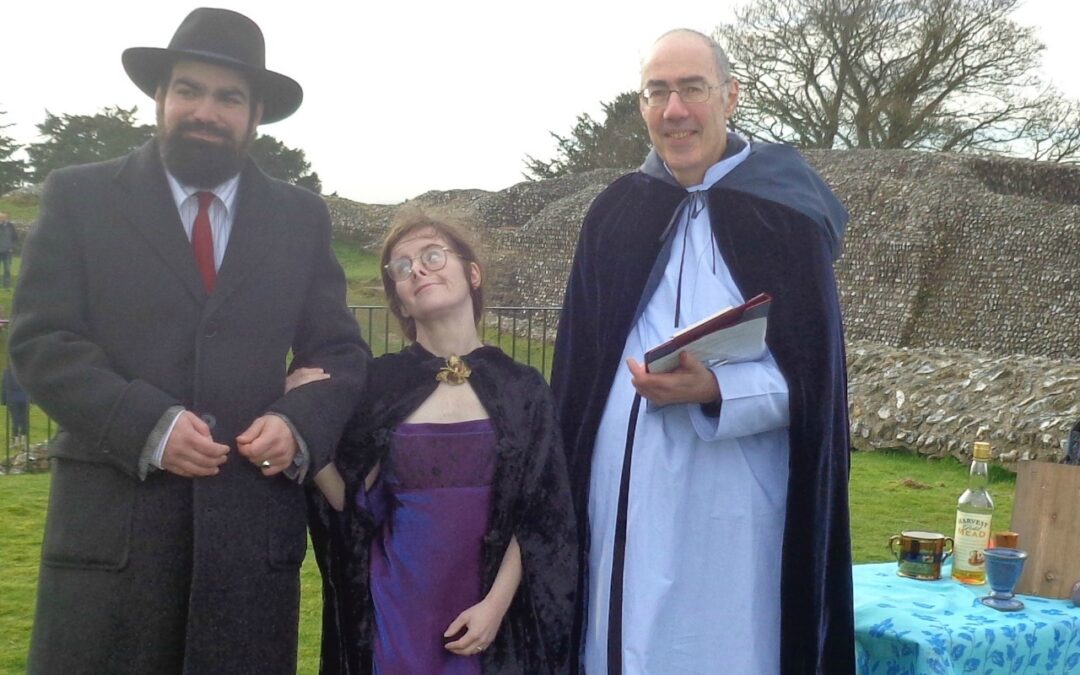
by Michael | Apr 9, 2024 | Blog
It’s normal enough to feel the worse for nerves on your wedding day. Or on any big occasion.
It’s not a bad thing in moderation. In fact, a bit of adrenaline doesn’t hurt at all.
However, you don’t want wedding day nerves that spoil your day. Or even the run-up.
So, what can you do, if you think you’ll be likely to suffer with too many butterflies?
There are tricks you can employ and/or you can accept help.
Techniques
One of the most reassuring things is knowing you are surrounded by trusted professionals. This applies, no matter how many professionals you employ. By that I mean planners, photographers, celebrants, florists, make-up artists, caterers, musicians, etc. etc.
If you have chosen these professionals with care, you know you can rely on them. They will provide a good service and won’t let you down, if something actually does go wrong.
But you can help yourself too.
Firstly, if you have prepared properly for your event (using experienced professionals), let go of the fear and worry. You’ve done all you can to prepare; now it’s down to others to do their job. There’s no point going over in your head what could go wrong. In truth, anything can happen – but it probably won’t! So don’t go looking for trouble, when there probably won’t be any.
If the worst comes to the worst, and something does go wrong, people are usually forgiving, especially if you’ve obviously tried your best.
If the thought of being in the public eye is too much for you, there are people that can help with phobias. I am particularly thinking of Isobel. Her website is www.intherighthands.co.uk, and she has helped a lot of people significantly. She’ll be happy to talk with you.
Remember, come what may, that the vast majority – if not all – of the people at your wedding will be batting for you. Just go out there and enjoy your day!
Feel free to discuss any points this may have raised.
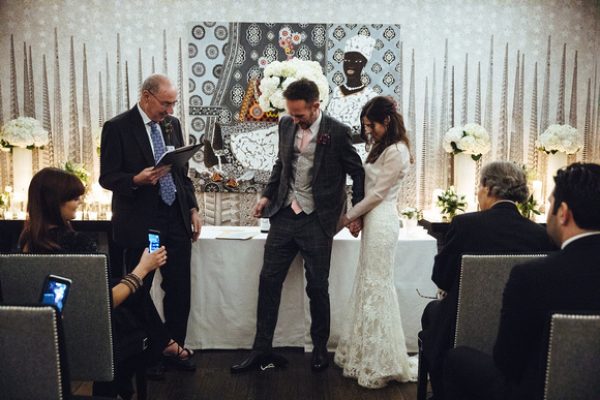
by Michael | Mar 26, 2024 | Blog
People don’t always get it.
It’s true that you can do without a civil celebrant for your life-cycle event – depending on what you are looking for.
You can have a full-religious ceremony in church (or an equivalent). Or, if you’re looking for a simple wedding ceremony that is 100% secular, you can go down the register office or Humanist route.
So why should you even consider an independent civil celebrant?
Personalisation
If you don’t want a standard, run-of-the-mill ceremony, a civil celebrant may be for you. If you want to make your ceremony stand out, then a celebrant may be perfect,
The celebrant-led ceremony can be exactly what you want it to be. It can be formal, semi-formal or informal. It can contain readings that you have chosen (or approved). It can include rituals that you want, that add meaning and beauty to the occasion. You can have readers of your choice involved. You might have your ‘story’ told as part of the service. There can be humour as well as solemnity. There can be as much – or little – religion as you choose.
Of course, with such a ceremony, you can select the venue. You are not bound to stipulations as you are with a Register Office (or church!) service. Indoors or outdoors, all is good (within reason!).
How a Celebrant can help
A good celebrant will ask plenty of questions at your first meeting. They should build up a picture of your vision for the day. They should be helpful and friendly, but professional. They need to be able to make suggestions and advise, where necessary, and help facilitate the service.
They should be a team member, very much in your corner.
A civil celebrant is trained to present in public, and, as well as offering writing skills, should demonstrate great presentation ability.
Most of all, your celebrant needs to be passionate and happy to go the extra mile. They want you to be more than just satisfied with your ceremony.
That’s certainly how I feel about my work, and would love to chat with you further, if this article has whetted your appetite.
photo: www.lyndseygoddard.com





